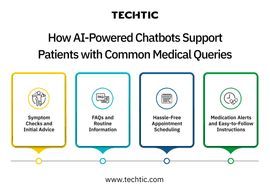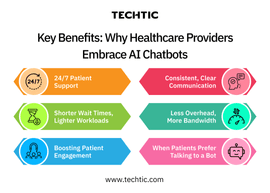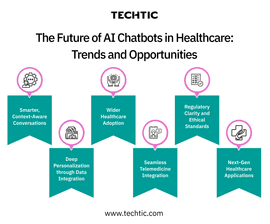AI Chatbots in Healthcare: Assisting Patients with Basic Medical Queries
Sector: AI + Data
Author: Nisarg Mehta
Date Published: 04/30/2025

Contents
- So... What Is a Healthcare Chatbot, Anyway?
- How AI Chatbots Assist Patients with Basic Medical Queries
- Real-World Use Cases: Chatbots Making an Impact in Healthcare
- Key Benefits: Why Healthcare Providers Embrace AI Chatbots
- Challenges and Limitations of AI Chatbots: Where They Still Fall Short
- Legal, Ethical & Privacy Realities of Healthcare Chatbots
- The Future of AI Chatbots in Healthcare: Trends and Opportunities
- Final Thoughts: Are AI Chatbots the Future of Patient Support?
- FAQs
In most clinics today, it’s the same story—phones ringing nonstop, staff stretched thin, and patients stuck waiting for answers to basic questions. A quick check-in about a symptom or a refill request can easily turn into a half-hour of hold music.
That’s where chatbots are starting to pull their weight.
These tools aren’t just the latest tech trend—they’re actually solving problems. More and more patients in the U.S. are using chat-based assistants to check symptoms, get medication info, or decide whether that sore throat means rest or a trip to urgent care.
Hospitals and clinics are starting to see the benefits too. Chatbots don’t take breaks, don’t call in sick, and can handle hundreds of questions at once. They free up real humans to focus on complex care, while still giving patients the fast responses they’re looking for.
So how do they actually work? And what can they realistically do (and not do) in a healthcare setting?
Let’s dig into what these tools are, where they’re already being used, and what healthcare teams should know before jumping in.
So... What Is a Healthcare Chatbot, Anyway?
At its core, a healthcare chatbot is just a piece of software that chats with patients—usually through a website, app, or even WhatsApp. But unlike the “live chat” bubbles you see on retail sites, these bots are built to understand health questions and guide patients with useful, accurate info.
They can help with stuff like:
- Answering FAQs (“How do I reschedule my appointment?”)
- Giving basic health guidance (“Should I see a doctor about this cough?”)
- Sending reminders (“Time for your 3 p.m. dose!”)
- Booking or changing appointments
Let’s say someone has a headache. A chatbot might ask a few follow-up questions, suggest home remedies if it’s mild, or recommend calling a doctor if certain red flags pop up.
They’re not replacing doctors—but they’re making the first steps a whole lot easier.
How AI Chatbots Assist Patients with Basic Medical Queries
AI chatbots have become reliable assistants for managing basic patient interactions. Instead of calling the clinic and waiting on hold, people now get answers to basic health questions within seconds—from their phone or laptop.

1. Symptom Checks and Initial Advice
Tools like Ada Health and Buoy ask a few guided questions to help patients figure out what might be going on. It’s not a diagnosis, but it’s enough to know if something can be treated at home or needs a doctor’s attention:
- Is this symptom serious?
- Can it be treated at home?
- Should the patient schedule an appointment right away?
Though not perfect, they do effectively guide patients toward the right next steps.
2. FAQs and Routine Information
Another major role for healthcare chatbots is answering frequent patient questions:
- When is the clinic open?
- How do I refill my prescription?
- Are there side effects to this medication?
A chatbot can handle all of that without making anyone wait on the phone. It’s a small shift that saves time and reduces stress.
3. Appointment Scheduling Made Simple
Chatbots also simplify scheduling. Patients can book, reschedule, or cancel appointments on the spot. Kaiser Permanente uses this to great effect through its patient portal—it cuts down on admin work and helps clinics run more smoothly.
4. Medication Reminders and Simple Instructions
Some chatbots, like Florence, are built just to remind patients when to take their meds. They also offer simple instructions so users don’t have to dig through pamphlets or search online.
Real-World Use Cases: Chatbots Making an Impact in Healthcare
Healthcare chatbots aren’t just theoretical tech—they’re already actively reshaping patient interactions. Let’s explore some practical examples to see how these tools have become game changers.
Quick Symptom Checks – Buoy and Symptomate
Buoy Health lets patients type in what’s wrong and walks them through a quick Q&A to figure out what to do next. Should you go to urgent care? Book a doctor’s appointment? Or just stay home and rest? You’ll know in a few minutes.
Apollo Hospitals runs a chatbot on WhatsApp called “24/7.” Patients message their symptoms and get immediate feedback. It’s especially helpful in easing worries and avoiding unnecessary hospital trips.
Mental Health Support – Woebot and Wysa
Mental health bots like Woebot and Wysa are seeing serious traction. They’re available 24/7, offering guided conversations based on cognitive behavioral therapy. People tend to reach out late at night—times when therapists usually aren’t around. And that alone makes these bots a huge value-add.
Medication and Treatment Reminders – Florence and Molly
Taking meds on time is a big challenge for a lot of patients. Florence helps by sending timely reminders and easy-to-follow instructions. Another AI chatbot, Molly, developed by Sensely, acts more like a virtual nurse—and has managed to get daily check-ins from patients using it.
Scheduling and Admin Tasks – Kaiser Permanente
Kaiser Permanente has built chatbot support right into its patient portal. Booking, rescheduling, cancellations—patients can handle it all through quick chatbot conversations. It’s saving staff hours of work and giving patients faster service, no phone queues required.
Key Benefits: Why Healthcare Providers Embrace AI Chatbots
There’s a reason more hospitals and clinics are leaning into chatbots—they’re not just helping out, they’re changing how things get done. Here’s what’s driving the shift:

24/7 Patient Support
Sickness doesn’t care about office hours. Whether it’s 2 a.m. or a Sunday afternoon, patients can get help instantly. Need to check a symptom or ask a quick question about your meds? A chatbot’s always on.
Reduced Waiting Times and Workloads
Reception desks and phone lines are slammed with questions like “What time are you open?” or “Can I take ibuprofen with this prescription?” Chatbots take on the repetitive stuff, so the staff can actually focus on patients who need real attention.
Getting Patients More Involved
Let’s be honest—calling a clinic can be a hassle. For many people, it’s easier to type out a quick question than to pick up the phone. That simplicity lowers the barrier. Patients who might normally hold back are more likely to speak up, check their symptoms, or follow through on treatment steps.
In fact, some health systems have seen chatbot engagement rates shoot past 90%. That’s a big deal—it means patients are actually using the tools, not ignoring them.
No Mixed Messages
Humans forget things. They misspeak. They get distracted. Chatbots don’t.
When you ask a bot a question, you get the same answer every time—and that kind of consistency matters, especially in healthcare. It ensures patients get clear guidance, and it helps providers stick to the right protocols.
Less Overhead, More Bandwidth
Hiring more admin staff isn’t always an option. But chatbots? They scale without much cost. Instead of bringing in a night shift receptionist or adding pressure to the day team, providers can offload routine work—scheduling, reminders, follow-ups—to a digital assistant that never clocks out.
That efficiency could save the healthcare industry billions by 2025. And not just in theory—it’s already happening.
When Patients Prefer Talking to a Bot
Some topics are tough to bring up in person. Whether it’s mental health, sexual health, or substance use, people don’t always feel comfortable saying things out loud. A chatbot offers a kind of privacy that feels safe—no judgment, no awkward pauses.
That extra comfort can lead to more honest answers, which means better care on the back end.
Challenges and Limitations of AI Chatbots: Where They Still Fall Short
Chatbots are helpful, but they’re not a silver bullet. Like any tool, they’ve got limitations—and it’s important to know where they fall short.
Sometimes, They Get It Wrong
If a bot is pulling from outdated or incomplete data, it can give poor advice. A misread symptom, a vague question, or even a spelling mistake can throw it off. That might not be a big deal when asking about a sore throat—but for more serious stuff, the risk is real.
Struggle With Complex Cases
Chatbots are fine for basic triage, not for complex diagnosis. They’re not built to untangle overlapping symptoms, rare conditions, or emotionally loaded questions. That still requires human experience—and probably always will.
Empathy Isn’t in the Code
Even the most advanced chatbot can’t replace human connection. It won’t pick up on fear in your voice or know when you just need someone to listen. For patients going through tough situations, a machine can feel cold and distant.
Privacy Still Needs Work
We’re talking about personal health data here. If a chatbot isn’t properly secured, that data’s at risk. HIPAA compliance isn’t just a checkbox—it’s a must. Without strong encryption and regular oversight, the whole system becomes a liability.
Not Everyone’s On Board
Some people simply don’t trust bots, especially older patients or those less familiar with tech. That resistance can be a barrier—and it’s on providers to bridge the gap. That means explaining what the chatbot can do, where its limits are, and how it fits into a broader care plan.
Legal, Ethical & Privacy Realities of Healthcare Chatbots
Launching a healthcare chatbot isn’t just about getting the tech to work. There are serious legal and ethical boxes to tick—and skipping any of them can get a provider into hot water.
Privacy Isn’t Optional in United States
In the U.S., anything that touches patient data has to follow HIPAA rules. That means encrypted chats, secure data storage, and tight controls on who gets access. If a chatbot’s collecting health info, providers need to be crystal clear about how that data is used, stored, and shared.
Being upfront builds trust. Patients deserve to know what’s happening with their information—full stop.
Say It Upfront: “This Is a Bot”
Patients need to know when they’re talking to AI, not a nurse. It’s not just good manners—it’s an ethical must. Clear labels like “I’m a virtual assistant, not a licensed medical provider” go a long way in setting expectations and avoiding confusion.
And anytime data is collected? Get consent first. No shady surprises.
Who’s Liable When a Bot Messes Up?
Here’s the murky part: if a chatbot gives bad advice and a patient gets hurt, who takes the fall? The clinic? The tech company? The line’s still fuzzy—and that’s risky.
The safest move? Build in guardrails. Chatbots should flag anything serious and recommend speaking to a real doctor. And providers should keep tabs on how the chatbot performs—don’t set it and forget it.
Watch for Hidden Bias
AI tools only know what they’re trained on. If the data used to train a chatbot isn’t diverse, the bot might overlook or misread symptoms in underrepresented groups. That’s a real problem, and it can impact care quality.
Regular audits, real-world testing, and inclusive training data are key to making sure everyone gets fair treatment.
Regulations Are Coming—Fast
Right now, the rules around healthcare chatbots are still evolving. But they won’t stay vague forever. Agencies like the FDA are starting to take a closer look, especially at bots that give anything close to diagnostic advice.
Smart providers are already preparing—because when the rules tighten, they’ll be ready, not scrambling.
The Future of AI Chatbots in Healthcare: Trends and Opportunities
Healthcare chatbots are only getting smarter. The technology is evolving fast, creating new possibilities for patient care and healthcare business operations. Here’s what the future holds:

Smarter and More Context-Aware Conversations
Tomorrow’s chatbots won’t just spit out answers—they’ll understand you better. They’ll remember past interactions, recognize patterns, and adapt their responses based on your health history or even your tone.
Picture this: your smartwatch shows a spike in heart rate, and your chatbot checks in to ask how you’re feeling. That kind of proactive care? It’s not far off.
Deep Personalization through Data Integration
Soon, chatbots will integrate closely with electronic health records and wearable health devices. This deeper integration means highly personalized responses.
For instance, if a diabetic patient asks about dietary choices, the chatbot could consider recent blood sugar readings, previous doctor advice, and personal health goals, delivering precise recommendations.
Broader Adoption Across Healthcare Systems
Chatbot adoption will rapidly increase, becoming standard for hospitals, clinics, and telehealth platforms. The global chatbot market is expected to reach $36.3 billion by 2032 (growing at a CAGR of 24.4%)—a clear sign of growing acceptance.
Providers not offering AI chatbot services may soon find themselves behind competitors who do.
Integration with Telemedicine and Clinical Care
Expect deeper integration between chatbots and telemedicine platforms. Bots will prep patients before their video visit, help with post-call summaries, and nudge them to follow up. Doctors get better context, patients get better continuity.
Think of it like a smart assistant that runs quietly in the background—keeping everything moving.
Regulatory Clarity and Ethical Standards
Expect clearer regulations around AI chatbot use in healthcare. Standards for patient safety, privacy, data security, and ethical AI use will mature.
Future chatbots may undergo certification or regular audits to ensure compliance. Providers staying ahead of these standards will benefit from increased patient trust and legal certainty.
Innovative Healthcare Applications
Chatbots won’t just stick to hospitals. They’ll help with public health campaigns, deliver health tips in local languages, even act as companions for older adults—offering daily check-ins, reminders, or just a friendly conversation to combat loneliness.
This tech isn’t replacing care—it’s extending it in ways we haven’t fully imagined yet.
Final Thoughts: Are AI Chatbots the Future of Patient Support?
The best path forward? Combine the strengths of AI chatbots—24/7 availability, efficiency, cost-savings—with the essential human elements of healthcare.
For healthcare teams and organizations, the upside is hard to ignore. Chatbots offer a real chance to improve how patients connect, ask questions, and stay engaged—all while easing the load on overworked staff.
But this isn’t a plug-and-play solution. These tools need to be rolled out with care. That means being upfront with patients, protecting their data, and making sure the bot always complements the work of real healthcare professionals—not tries to replace them.
There’s no doubt that smarter, more capable chatbots are coming. And the providers who start using them thoughtfully—now, not later—will have an edge. They’ll offer faster, better experiences without sacrificing the human touch.
It’s not a question of if your practice should explore chatbots. It’s a matter of when—and how well you plan to make them work.
Are you ready to harness AI chatbots to elevate patient care in your healthcare practice?
Get in touch with Techtic Solution’s HealthTech experts. Our AI solution experts are well-versed with the US compliances and know how to craft solutions that fall under healthcare regulations while delivering the best patient experience. Let’s talk about your idea!
FAQs
Q: How Chatbots are important in Healthcare?
Chatbots play a vital role in modern healthcare by offering 24/7 patient assistance, streamlining appointment bookings, providing instant answers to medical queries, and supporting chronic disease management. They help reduce the workload of healthcare providers, improve patient engagement, and enhance accessibility to healthcare services. With AI integration, healthcare chatbots are becoming smarter, more personalized, and essential in delivering efficient, patient-centric care.
Q: What are the features of Healthcare Chatbots?
Healthcare chatbots come with a wide range of features designed to enhance patient care and streamline medical services. Key features include 24/7 patient support, appointment scheduling, symptom checking, medication reminders, real-time health updates, and integration with electronic health records (EHRs). Advanced chatbots also use natural language processing (NLP) to understand medical queries, provide personalized responses, and ensure secure handling of sensitive health information.
Q: What Are Some Common Types of Healthcare Chatbots?
Healthcare chatbots are designed to assist users with various medical and wellness needs. Here are a few common types:
Health Insurance Assistants – Help patients understand their coverage, file claims, and find in-network providers.
Therapy & Wellness Promotions – Provide discounts, coupons, or resources for mental health services and self-care.
Fitness & Nutrition Coaches – Offer personalized workout plans, diet tips, and weight management support.
Chronic Condition Support – Assist users in managing long-term illnesses like diabetes or hypertension.
Q: How do AI chatbots assist patients with basic medical queries?
AI chatbots assist patients with basic medical queries in several ways:
- Instant Access to Information: AI chatbots provide instant responses to common medical questions, offering information about symptoms, conditions, treatments, and general healthcare advice.
- Symptom Analysis: By gathering information about the patient’s symptoms, AI chatbots can suggest possible conditions or recommend when to seek professional medical attention, helping users determine the next steps in their healthcare journey.
- Guidance on Over-the-Counter Medications: Chatbots can suggest suitable over-the-counter medications for minor ailments, providing dosage recommendations and information on potential side effects.
- Health Tips and Prevention: AI chatbots can share useful health tips, advice on maintaining a healthy lifestyle, and preventive measures to reduce the risk of common diseases.
- Mental Health Support: For patients with mental health concerns, AI chatbots offer a listening ear, provide coping strategies, and suggest resources or referrals for professional mental health support.
- 24/7 Availability: AI chatbots are available around the clock, ensuring that patients can access basic medical guidance anytime, even outside regular office hours.
Latest Tech Insights!
Join our newsletter for the latest updates, tips, and trends.



